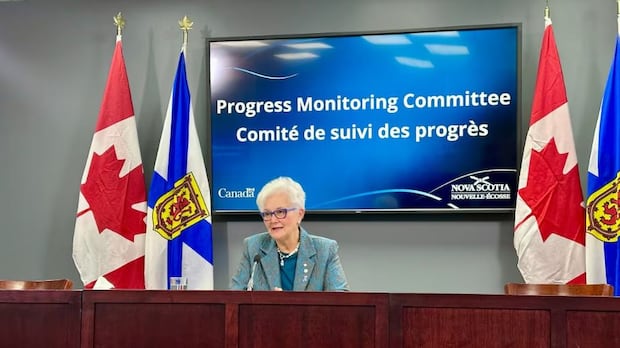N.S. fire chief questions lack of emergency support, alert delay in recent flooding

As questions remain about why Nova Scotia municipalities didn’t request an emergency alert during the recent flash flooding, one fire chief says there wasn’t enough support from local emergency officials — who don’t appear to have followed their own policies.
On July 11, heavy rain fell across western and central Nova Scotia, hitting the Annapolis Valley especially hard. It caused flash flooding that led to a 13-year-old’s death in Wolfville and major road damage.
“This is the worst flooding I’ve seen in my lifetime here,” said Jason Ripley, chief of the volunteer fire department in Greenwich, which is just outside Wolfville.
But Ripley said the Kings Regional Emergency Management Office (REMO) never activated its emergency co-ordination centre during the flooding — even though he believed its highest level was justified based on Kings County’s own emergency management plan.
That plan states level 1, or full activation, is triggered by a regional disaster with multiple sites, multiple agencies involved and support required, and would have notified the provincial Emergency Management Office (EMO).
“That’s one of my big questions, I guess, as to why that didn’t occur,” Ripley said.
He said conditions started to get bad in his area around 6 p.m. that Thursday. His crew went to calls of flooded basements and driveway washouts — including at the Old Orchard Inn, which had dozens of guests and staff.
He talked with REMO — which serves the four municipalities in Kings County — a few times that evening with updates about what was happening, and requests for sandbags.
But sandbags weren’t available, and Ripley said another request to have the province help in closing down some roads wasn’t completed because REMO “didn’t have any contacts to reach them after-hours.” Ripley said he was told to go through his own dispatch centre, which was “extremely overwhelmed.”
His message was delayed but public works crews eventually did arrive.
Ripley himself didn’t request an emergency alert. He said he only knew what was happening in his small slice of the county, and Kings REMO was responsible for the wider view and when to send alerts.
If the conditions he was seeing were consistent across the county, Ripley said, “it would be my belief that they would then take the reasonable step of issuing the alert.”
But the request was never made by Kings, or any other municipality.
Instead, Municipal Affairs Minister John Lohr — who lives in one of the communities hit by the storm — called the provincial EMO at 7:15 p.m. to have more staff come in. That centre took the unusual step to issue an alert at 8:30 p.m. based on information they were getting, warning of flash floods in parts of Digby, Annapolis, Kings and Hants counties.
Eli Young, a 13-year-old boy, was playing at a park in Wolfville when he was pulled into rushing water around 7:40 p.m. His body was recovered a few hours later.
Ripley said crews in his area helped in the dramatic flooding in West Hants last year when four people died.
“There were a lot of lessons learned as a result of that and it was just somewhat disappointing to me that those lessons, which were easily available to us, weren’t very well applied,” he said.
Kings REMO declined an interview request.
Mayor says he will not be ‘second-guessing’
Mayor Peter Muttart of the County of Kings said in an email that the emergency system is a network, and there will always be “different points of view at various levels” after such an event.
Muttart said there will be an assessment of how the system performed and changes will be made if areas are identified that need improvement.
“We will not be criticizing or second-guessing or commenting in the meantime,” he wrote. “That could be hurtful and demoralizing to the many first responders and victims of this event all of whom have so much invested in the response and some of whom have varying degrees of trauma to deal with at this time. We are proud of our responders who are all critical links in the chain.”
Wolfville Mayor Wendy Donovan declined an interview because the incident is “still being debriefed with staff and first responders,” she said in an email.
Kentville and Berwick, the other municipalities who use the Kings REMO, didn’t respond to requests for interviews.
Chief Brett Tetanish of the Brooklyn Volunteer Fire Department in West Hants said flooding calls had just started coming in as the emergency alert went out at 8:30 p.m.
For the first responders who’d been out for hours, Tetanish said “that the alert came a little late — but for us it was in a timely manner.”
Tetanish said alerts are helpful, but it’s up to the public to pay attention to the weather around them.
Last week, Lohr wrote to all Nova Scotia municipalities asking them to be “more vigilant” in issuing alerts because they have the best information about what’s happening on the ground.
Warden Linda Gregory of the Municipality of Digby called the tone of Lohr’s letter offensive.
“The letter came out to me like I’m a two-year-old, and I’m a little older than two,” Gregory said.
She said their municipal emergency officials were monitoring everything, and because they weren’t hit nearly as hard as neighbouring counties, an alert wasn’t needed from their perspective. In fact, she said the eventual alert naming Digby caused confusion in her municipality because the roads were clear by 8:30 p.m.

Lohr said in his letter that he was making immediate changes to streamline the alert system, while legislation to improve it permanently is expected this fall.
Municipalities will now be able to issue alerts without getting the messages checked by the provincial EMO. Lohr’s letter said they can send a message to the Shubenacadie Radio Communications Centre, which will move it to the alert platform to be sent out, which should take 15 minutes once it’s received.
For the first time, that access will now be offered to municipal police forces, fire services and other first responders.
Provincial spokesperson Heather Fairbairn said expanding access to first responders will require consultation and training. That work will begin this summer.




